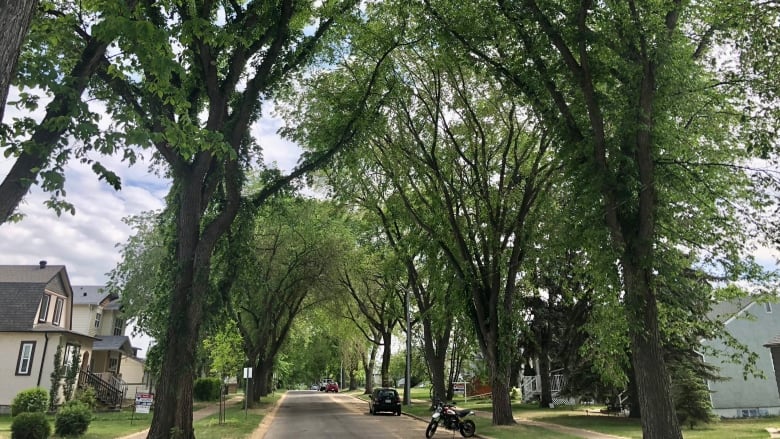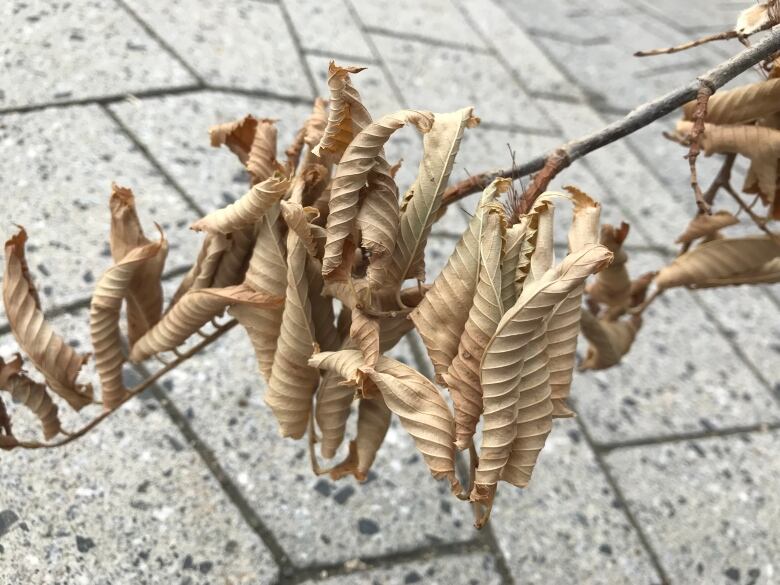Invasive fungus that kills elm trees detected in Edmonton for first time, city says
City bracing for 'ongoing fight' against Dutch elm disease, official says

Dutch elm disease has been detected for the first time in Edmonton, leaving thousands of trees vulnerable to a fatal infestation the city expects to fight for years to come.
The fungus has been detected in several trees in the Killarney neighbourhood in northeast Edmonton, and along the Yellowhead Corridor East.As of Aug. 30, a total of four trees have tested positive for the disease, the city said in a statement Tuesday.
Dutch elm disease is a costly and deadly fungus that poses a threat to all species of elm trees in Alberta, including90,000 elm trees owned by the city. In some of Edmonton's matureneighbourhoods, boulevards are lined solely with old, sweeping elms.
Mark Beare, the city's director of infrastructure operations, said city staff are preparingfor a prolonged battle with the destructive fungus.
"This is going to be an ongoing fight from here on out," Beare said in an interview Tuesday.
"We do have an action plan," he said. "But I do believethis is something that we're going to be living with and battling for years to come."
Beare said the city has been bracing for years for the potential arrival of the destructive fungus as it crept westward across the country, devastating urban forest canopies. An action plan, now being implemented to limit the damage, was first developed in 2020.
Beare said Edmonton has enjoyed the largest crop of elm trees untouched by the diseaseuntil now, and crews are eager to save all they can.
"Often it has seemedthat it's not a matter of if, but when," he said. "We've been prepared for this, we've been anticipating it, but it doesn't make it any less concerning when we actually do see it arrive in our city."
City officials are working with the Canadian Food Inspection Agency(CFIA) and the Alberta government to contain the spread and limit the damage.
Crews are assessing and evaluating all of the elms in the impacted neighbourhoods. In areas considered most at risk, trees showing signs of infection will be removed immediately. City officials expectthe number of confirmed infectionsto rise.
"We don't have any specific numbers that we're bracing for at this time," Beare said. "We're talking hundreds of elm trees in the affected area, both public and private.
"Our goal right now is to conduct those visual surveys as quickly as possible ... Itis very much an evolving situation and we would anticipate to get further positive tests based on how this does spread."
A fatal infection
The fungus, which clogs a tree's water-conducting systems, has killed millions of elms in North America over the past century.Communities have spent millions in efforts to control the spread. Some have had to cull entire streets of elms.
Dutch elm disease was discovered in Canada in 1944 and has since become established in all provinces except British Columbia, Alberta, and Newfoundland and Labrador.
In Alberta, both Dutch elm pathogens and the elm bark beetles that carry them are named declared pests. Alberta and B.C. are the only provinces remaining in Canada not officially listed as infestation zones by the CFIA.
The fungus is primarily spread through the tree canopy by three species of beetle; the smaller European elm bark beetle, the banded elm bark beetle and the native elm bark beetle.
The beetles are attracted to weak and dying trees, which serve as breeding sites. Once the beetles reach adulthood and take wing, they fly to healthy elms to feed, bringing the fungus with them.
The infection moves quickly. Leaves on infected treeswilt, drop, curl and turn brown as the disease spreads from branch to branch.Infected trees usually die within a season or two.
In Edmonton, testing was triggered when an inspection crew spottedthe presence of beetles on a diseased tree in August.
City crews observed symptoms of Dutch elm disease, along with the first appearance of live banded elm bark beetles in American elm trees.Samples from the diseased trees were submitted for testing and the CFIA was notified.
On Aug. 27,lab results confirmed the presence of the fungus, the city said.On Aug. 29, two additional cases were confirmed.
Limiting the damage
The city said all infected trees have been removed. Crewsare conducting targeted elmremoval to reduce the habitat of the beetles that spread the fungus.
City-owned elms with significant leaf death at the top of the tree, small elms, and elms in unsuitable growing locations, such as alleys, are being considered for immediate removal.
Elms along 127th Avenue have been injected with an insecticide to improve their defence against insects. The treatmentsare expected to continue.
Spotting an infestation
Edmontonians are encouraged to report any signs of an infestation to 311.Infected trees may have dead branches orbrowning leaves. The trunks may haveholes or sawdust on the bark from burrowing beetles.
Beare encouraged Edmontonians to educate themselves on the infection and follow all city guidelines on management.
He said keeping tabs on infestations will be a community effort.
"I am hopeful and I have the utmost confidence in the professionals that we have within our city that are out being proactive and inspecting the the trees, that we are going to be able to contain this."
A provincewide inventory in 2017identified at least 600,000 elms growing in communities across Alberta.In Edmonton, elm species account for 22 per cent of the city's tree inventory.














_(720p).jpg)


 OFFICIAL HD MUSIC VIDEO.jpg)
.jpg)



























































































